14 Opera Flags Tweaks for Better Browsing Experience
Similar to other browsers, Opera also comes with experimental features that can enhance your browsing experience. Whether you are looking to speed up browsing, enhance security or just want to tweak the user interface, you should be able to find an Opera flag that can help with it.
Here’s a list of 14 handy Opera flags that will improve your browsing experience. Though, these experimental features are still not finalized and may backfire, but we have tried to pick the most stable ones.
If any of these tweaks negatively affect your browsing, simply set it to default again.
10 Reasons Why You Should Switch to Opera Browser Right Now
Opera is one of the most underrated browsers out there. Even though it usually pops up in the... Read more
Access Opera Flags Page
You can go to Opera Flags page to access all these experimental features. In the Opera address bar, type "opera:flags" and hit Enter. All the experimental features will open up and you can use the search bar at the top to search for specific feature.
Note: To access the features listed below, you can enter their name in the above search bar to directly move to them. We have also listed direct links below each flag. If you are using Opera, simply click on the link and you will be automatically directed to the particular flag.


1. Enable Opera VPN in private window only
If you are an Opera user, then you may already know that Opera recently added a free VPN in its browser. When you enable it, you will see a VPN button next to the address bar that you can use to turn on/off the VPN.
I usually don’t use VPN all the time, but when I do use VPN; I use it in private window for extra anonymity. If you are like me then there is no need of a big VPN button in normal browsing.
Here is how you do it:
- Enable "Opera VPN" flag in the experiments.
- Then disable the actual Opera VPN option from the Opera "Privacy & security" setting.
Now the VPN button will only show up when you will open a private window.
Opera VPN: (opera://flags/#browser-vpn)
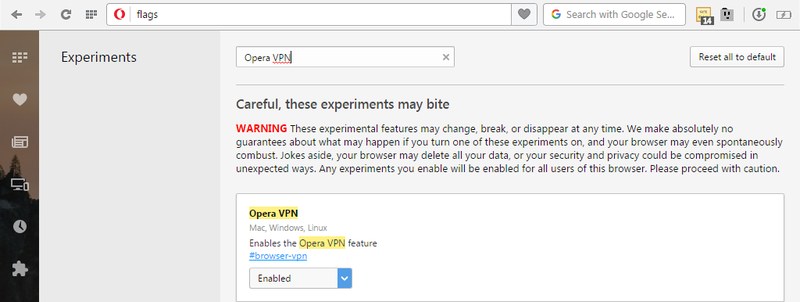

2. Disable Search Box in the Address bar
Right next to the address bar, is a search bar that you can use to search your required queries. If you prefer to enter your queries directly in the address bar, you can opt to remove the search bar. Well, the extra space could be used for managing extensions.
To remove the search bar, disable the "Search box in the address bar" flag. After restarting, you will see that the search bar has been removed.
Search box in the address bar: (opera://flags/#search-box-in-address-bar)
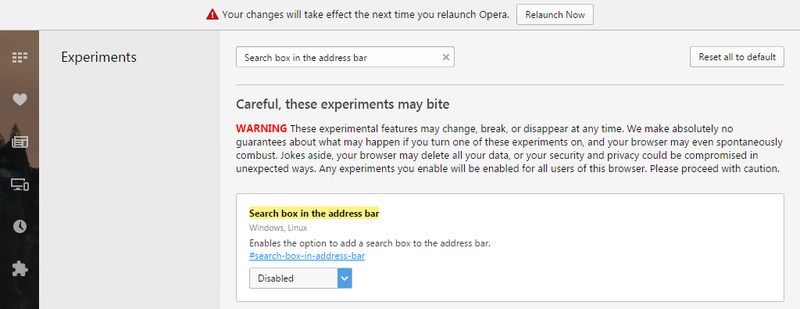

3. Turn off User Surveys
Have you been requested to complete a survey to improve browsing experience? If you don’t like such requests, you can turn them off from these Opera flags.
Search for "User surveys" flag and disable it. Now these surveys will leave you alone.
User surveys: (opera://flags/#surveys)
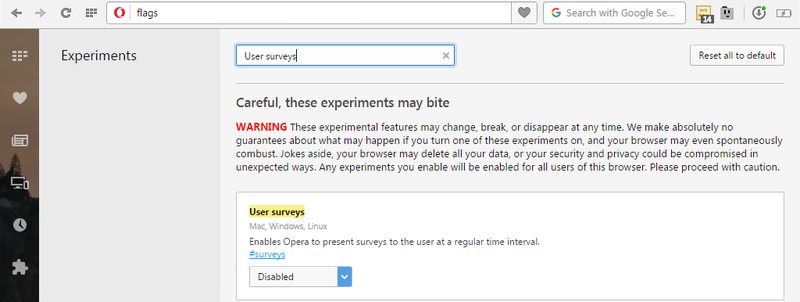

4. Warn about local, unknown roots
If an HTTPS connection is being hosted locally with public unknown roots, you can tell Opera to let you know about it. This is vital if you are visiting an unknown website with locally hosted HTTPS connection, and want to be careful before trusting them with your data.
Enable the flag "Warn about local, unknown roots" and you see unprotected connection warning whenever you will visit a website with SSL certificates having public unknown roots.
Warn about local, unknown roots: (opera://flags/#warn-for-unknown-root)


5. Enable smooth scrolling
Usually stuttering happens when you scroll through web pages using the mouse wheel or the keyboard keys. You can enable an Opera flag to make scrolling animation smooth and easy on the eyes.
Enable the "Smooth scrolling" flag and you will have bumpless read and scroll.
Smooth scrolling: (opera://flags/#smooth-scrolling)


6. Enable overlay scrollbars
There is a new minimal scroll bar available for Opera that can be enabled from these experimental features. It looks similar to Chrome’s scroll bar but sits hidden on the sides and less bulky. Just move your mouse over to trigger scroll bar to emerge.
Enable "Overlay scrollbars" flag to replace the scroll bar. You will also have to make sure that "Threaded scrolling" flag is enabled if you want to see the scroll animations.
Overlay scrollbars: (opera://flags/#overlay-scrollbars)
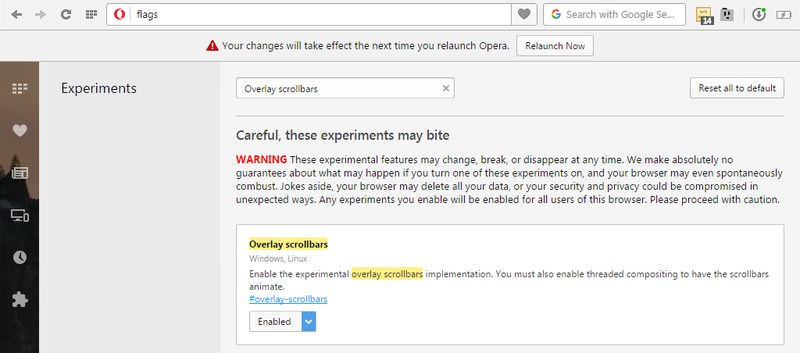

Threaded scrolling: (opera://flags/#disable-threaded-scrolling)


7. Enable experimental canvas features
It is one of the best flags to speeds up Chrome and fortunately it is also available for Opera. This feature speeds up page loading time by not loading page content that isn’t visible to the user. You will not see any visible difference while this flag is enabled, but you should see faster page loading speed.
Just enable "Experimental canvas features" flag and experience the magic.
Experimental canvas features: (opera://flags/#enable-experimental-canvas-features)
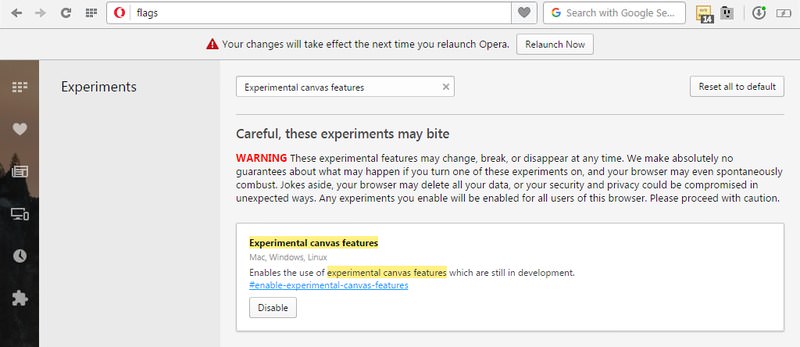

8. Warn about risky downloads
By default, Opera will not warn you about potentially malicious download files, but you can force it to warn you. To receive warnings, you will have to tweak two different flags.
Enable "Prompt on risky downloads" flag, then disable "Show save file dialog on risky download" flag.
Now you will receive a warning whenever you downloaded something from untrusted source. Do keep in mind that Opera is very loose about these warnings, so many of them will be false.
Show save file dialog on risky download: (opera://flags/#show-save-file-dialog-on-risky-download)
Prompt on risky downloads: (opera://flags/#prompt-on-risky-download)


9. Use simple cache for HTTP web pages
You may already know that your browser caches web pages data to skip downloading the whole page again when you revisit. Simple Cache is a new caching system that uses filesystem for space allocation. It is faster than the current caching system, which makes it worth checking out.
Enable "Simple Cache for HTTP" flag and you may notice that HTTP web pages will load faster when you revisit them.
Simple Cache for HTTP: (opera://flags/#enable-simple-cache-backend)
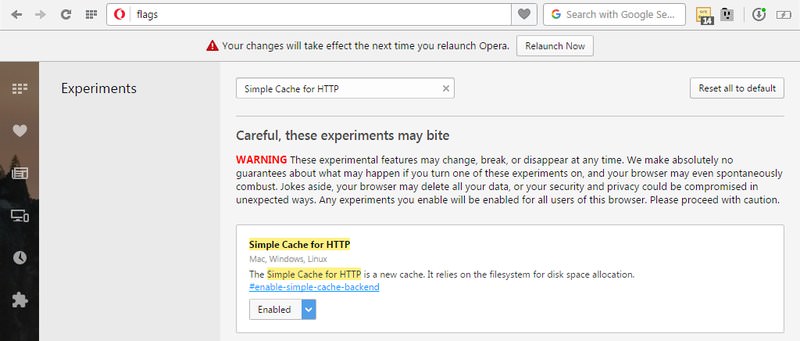

10. Increase number of raster threads
Raster threads are responsible for rendering images on a web page. Therefore, increasing the total number of raster threads will also increase image loading time and overall page loading time. Search for the flag "Number of raster threads" and set it’s value to "4" (maximum).
Number of raster threads: (opera://flags/#num-raster-threads)
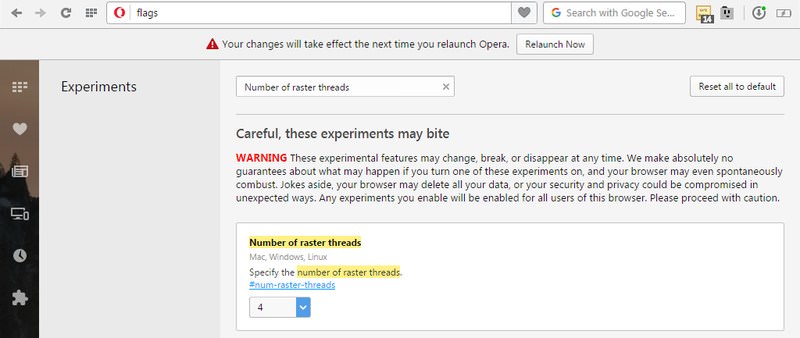

11. Force Autofill
Some online forms prevent Autofill feature of your browser so you have to input all the data manually. It’s a good security measure, but very annoying as well. You can force Opera to autocomplete such forms using one of the flags.
Enable the flag "Autofill HTML forms even if the ‘autocomplete’ attribute is set to ‘off‘" to enable this feature.
Autofill HTML forms even if the ‘autocomplete’ attribute is set to ‘off’: (opera://flags/#enable-autofill-ignore-autocomplete-off)


12. Use FontCache scaling
This is another flag to speed up page loading time. Opera can use existing downloaded fonts in cache to speed up web page using the same fonts.
Enable "FontCache scaling" flag to take advantage of fonts in cache.
FontCache scaling: (opera://flags/#enable-font-cache-scaling)


13. TCP Fast Open (Linux Only)
This flag is only available for Opera users on Linux to speed up page loading time. It makes the connection process with website server faster when you revisit the same website. If the connection is created faster, it means that the page starts loading faster.
Enable "TCP Fast Open" flag in Opera if you have Linux.
TCP Fast Open: (opera://flags/#enable-tcp-fast-open)
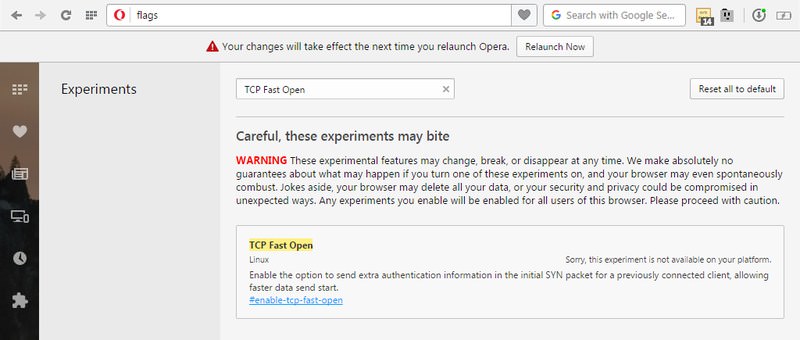

14. Enable the “stale-while-revalidate” cache directive
This flag basically increases the life of cache used before update is needed by the web page content. If "stale-while-revalidate" is enabled, the old cache will be used to load the web page and newer version of the page will be updated in the background.
Any new changes will also be replaced afterwards. This allows you to efficiently use browser cache to speed up page loading speed and also access the updated version of the page.
Enable the flag "Enable the “stale-while-revalidate” cache directive" to use this feature.
Enable the “stale-while-revalidate” cache directive: (opera://flags/#enable-stale-while-revalidate)
Note: After tweaking these features, you will have to restart Opera to apply the changes.
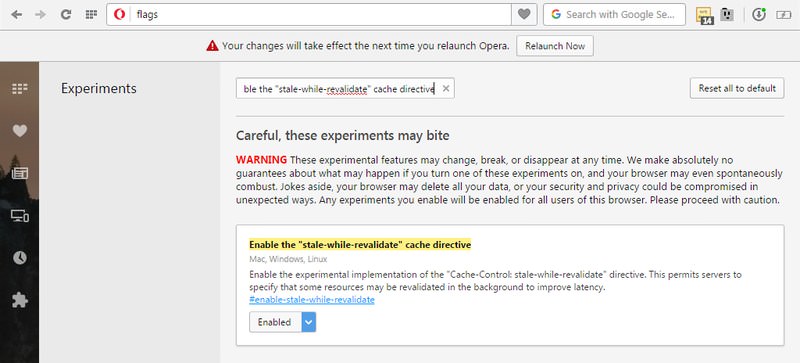

Conclusion
These were some of the handy Opera flags that will help you improve the browser’s speed, security and design. I am personally using most of the flags mentioned above and haven’t faced any jitters yet. Let us know if you do experience any impacts your browsing experience, and do share with us in the comments to help other users.
The post 14 Opera Flags Tweaks for Better Browsing Experience appeared first on Hongkiat.
Comments
Post a Comment